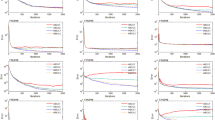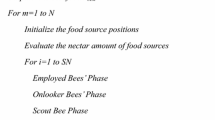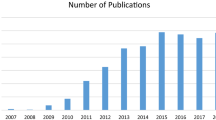Abstract
The artificial bee colony optimization (ABC) is a population-based algorithm for function optimization that is inspired by the foraging behavior of bees. The population consists of two types of artificial bees: employed bees (EBs) which scout for new, good solutions and onlooker bees (OBs) that search in the neighborhood of solutions found by the EBs. In this paper we study in detail the influence of ABC’s parameters on its optimization behavior. It is also investigated whether the use of OBs is always advantageous. Moreover, we propose two new variants of ABC which use new methods for the position update of the artificial bees. Extensive empirical tests were performed to compare the new variants with the standard ABC and several other metaheuristics on a set of benchmark functions. Our findings show that the ideal parameter values depend on the hardness of the optimization goal and that the standard values suggested in the literature should be applied with care. Moreover, it is shown that in some situations it is advantageous to use OBs but in others it is not. In addition, a potential problem of the ABC is identified, namely that it performs worse on many functions when the optimum is not located at the center of the search space. Finally it is shown that the new ABC variants improve the algorithm’s performance and achieve very good performance in comparison to other metaheuristics under standard as well as hard optimization goals.
Similar content being viewed by others
References
Abbass HA (2001) Marriage in honeybees optimization (MBO): a haplometrosis polygynous swarming approach. IEEE Press, Piscataway, NJ, pp 207–214
Akay B, Karaboga D (2009) Parameter tuning for the artificial bee colony algorithm. In: Nguyen N, Kowalczyk R, Chen SM (eds) Proceedings of the ICCCI 2009, LNCS, vol 5796. Springer, Berlin/Heidelberg, Germany, pp 608–619
Bahamish HAA, Abdullah R, Salam RA (2009) Protein tertiary structure prediction using artificial bee colony algorithm. In: Proceedings of the Asia International Conference on Modelling & Simulation. IEEE Computer Society, pp 258–263
Baykasoglu A, Oezbakr L, Tapkan P (2007) Artificial bee colony algorithm and its application to generalized assignment problem. In: Chan FTS, Tiwari MK (eds) Swarm intelligence: focus on ant and particle swarm optimization. Itech Education and Publishing, Vienna, Austria, pp 113–144
Bellman R (1961) Adaptive control processes: a guided tour. Princeton University Press, Princton, NJ
Biesmeijer JC, de Vries H (2001) Exploration and exploitation of food sources by social insect colonies: a revision of the scout-recruit concept. Behav Ecol Sociobiol 49(2): 89–99
Blum, C, Merkle, D (eds) (2008) Swarm intelligence: introduction and applications. Springer, Berlin/Heidelberg, Germany
Bonabeau E, Dorigo M, Theraulaz G (1999) Swarm intelligence: from natural to artificial systems. Oxford University Press, Oxford
Diwold K, Beekman M, Middendorf M (2010) Bee nest site selection as an optimization process. In: Proceedings of the 12th international conference on the synthesis and simulation of living systems (Alife XII). The MIT Press, Cambridge, MA, pp 626–633
Diwold K, Beekman M, Middendorf M (2010) Honeybee optimisation an overview and a new bee inspired optimisation scheme. In: Hiot LM, Ong YS, Panigrahi BK, Shi Y, Lim MH (eds) Handbook of swarm intelligence, adaptation, learning, and optimization, vol 8. Springer, Berlin/Heidelberg, Germany, pp 295–327
Dorigo M, Maniezzo V, Colorni A (1996) The ant system: optimization by a colony of cooperating agents. IEEE Trans Syst Man Cybern–Part B 26(1): 29–41
Dornhaus A, Kluegl F, Oechslein C, Puppe F, Chittka L (2006) Benefits of recruitment in honey bees: effects of ecology and colony size in an individual-based model. Behav Ecol 17(3): 333–344
Forbes N (2004) Imitation of life: how biology is inspiring computing. The MIT Press, Cambridge, MA
Holm S (1979) A simple sequentially rejective multiple test procedure. Scand J Stat 6: 65–70
Huang T, Mohan AS (2005) A hybrid boundary condition for robust particle swarm optimization. IEEE Antennas Wirel Propag Lett 4: 112–118
Janson S, Middendorf M (2005) A hierarchical particle swarm optimizer and its adaptive variant. IEEE Trans Syst Man Cybern–Part B 35(6): 1272–1282
Karaboga D (2005) An idea based on honey bee swarm for numerical optimization. Tech. rep., Erciyes University, Engineering Faculty
Karaboga D (2009) A new design method based on artificial bee colony algorithm for digital IIR filters. J Franklin Inst 346(4): 328–348
Karaboga D, Akay B (2007) Artificial bee colony (ABC) algorithm on training artificial neural networks. In: IEEE 15th Signal Processing and Communications Applications. IEEE Press, Piscataway, NJ, pp 1–4
Karaboga D, Akay B (2009) A comparative study of artificial bee colony algorithm. Appl Math Comput 214(1): 108–132
Karaboga D, Akay B (2009) A survey: algorithms simulating bee swarm intelligence. Artif Intell Rev 31: 61–85
Karaboga D, Basturk B (2007) Artificial bee colony (ABC) optimization algorithm for solving constrained optimization problems. In: Melin P, Castillo O, Aguilar L, Kacprzyk J, Pedrycz W (eds) Foundations of fuzzy logic and soft computing, LNCS, vol 4529. Springer, Berlin/Heidelberg, Germany, pp 789–798
Karaboga D, Basturk B (2007) A powerful and efficient algorithm for numerical function optimization: artificial bee colony (ABC) algorithm. J Glob Optim 39(3): 459–471
Karaboga D, Basturk B (2008) On the performance of artificial bee colony (ABC) algorithm. Appl Soft Comput 8: 687–697
Karaboga D, Akay B, Ozturk C (2007) Artificial bee colony (ABC) optimization algorithm for training feed-forward neural networks. In: Torra V, Narukawa Y, Yoshida Y (eds) Modeling decisions for artificial intelligence, LNCS, vol 4617. Springer, Berlin/ Heidelberg, Germany, pp 318–329
Karci A (2004) Imitation of bee reproduction as a crossover operator in genetic algorithms. In: Zhang C, Guesgen HW, Yeap WK (eds) PRICAI 2004: trends in artificial intelligence, LNCS, vol 3157. Springer, Berlin/Heidelberg, Germany, pp 1015–1016
Kennedy J, Eberhart R (1995) Particle swarm optimization. In: Proceedings of the IEEE International Conference on Neural Networks. IEEE Press, Piscataway, NJ, vol 4, pp 1942–1948
Kirkpatrick S, Gelatt CD, Vecchi MP (1983) Optimization by simulated annealing. Science 220(4598): 671–680
Kramer O (2010) Iterated local search with powells method: a memetic algorithm for continuous global optimization. Memet Comput 2: 69–83
Krink T, Filipic B, Fogel G, Thomsen R (2004) Noisy optimization problems - a particular challenge for differential evolution? In: Proceedings of the Congress on Evolutionary Computation. IEEE Press, Piscataway, NJ, vol 1, pp 332–339
Lemmens N, de Jong S, Tuyls K, Nowé A (2008) Bee behaviour in multi-agent systems. In: Tuyls K, Nowe A, Guessoum Z, Kudenko D (eds) Adaptive agents and multi-agent systems III. Adaptation and multi-agent learning, LNCS, vol 4865. Springer Berlin/Heidelberg, Germany, pp 145–156
Marinakis Y, Marinaki M, Matsatsinis N (2010) A bumble bees mating optimization algorithm for global unconstrained optimization problems. In: González J, Pelta D, Cruz C, Terrazas G, Krasnogor N (eds) Nature inspired cooperative strategies for optimization (NICSO 2010), studies in computational intelligence, vol 284. Springer, Berlin/Heidelberg, Germany, pp 305–318
Mattila HR, Seeley TD (2007) Genetic diversity in honey bee colonies enhances productivity and fitness. Science 317: 362–364
Nelder JA, Mead R (1965) A simplex method for function minimization. Comput J 7(4): 308–313
Pham D, Ghanbarzadeh A, Koc E, Otri S, Rahim S, MZaidi (2006) The bees algorithm a novel tool for complex optimisation problems. In: Proceedings of IPROMS 2006 conference, pp 454– 461
Powell M (2009) The bobyqa algorithm for bound constrained optimization without derivatives. Tech. Rep. NA2009/06, Department of Applied Mathematics and Theoretical Physics, University of Cambridge
Sato T, Hagiwara M (1997) Bee system: finding solution by a concentrated search. In: IEEE International Conference on Systems, Man, and Cybernetics, 1997. ‘Computational Cybernetics and Simulation’. IEEE Press, Piscataway, NJ, vol 4, pp 3954–3959
Schmickl T, Crailsheim K (2008) Trophallaxis within a robotic swarm: bio-inspired communication among robots in a swarm. Auton Robots 25: 171–188
Seeley TD (2010) Honeybee democracy. Princeton University Press, Princeton, NJ
Socha K, Dorigo M (2008) Ant colony optimization for continuous domains. Eur J Oper Res 185(3): 1155–1173
Storn R, Price K (1997) Differential evolution—a simple and efficient heuristic for global optimization over continuous spaces. J Glob Optim 11: 341–359
Teodorovic D, Lucic P, Markovic G, Orco MD (2006) Bee colony optimization: Principles and applications. In: 8th seminar on neural network applications in electrical engineering, NEUREL 2006. IEEE Press, Piscataway, NJ, pp 151–156
Trelea IC (2003) The particle swarm optimization algorithm: convergence analysis and parameter selection. Inf Process Lett 85: 317–325
Wedde HF, Farooq M (2005) Handbook of Bioinspired Algorithms and Applications, Chapmann & Hall, chap New ideas for developing routing algorithms inspired by honey bee behavior, pp 321–339
Author information
Authors and Affiliations
Corresponding author
Rights and permissions
About this article
Cite this article
Diwold, K., Aderhold, A., Scheidler, A. et al. Performance evaluation of artificial bee colony optimization and new selection schemes. Memetic Comp. 3, 149–162 (2011). https://doi.org/10.1007/s12293-011-0065-8
Received:
Accepted:
Published:
Issue Date:
DOI: https://doi.org/10.1007/s12293-011-0065-8




